How To Get MD-101: Managing Modern Desktops Certifications

Although Microsoft certifications have become more complex. The growing demand for Managing Modern Desktops Certifications also indicates that the Microsoft certification industry is booming – instead of paying for advice, consider how to get yourself MD-101: Managing Modern Desktop Certifications.
To earn certification, you must take the MD-101 exam, which covers device management, customer computer networking, policy-based management, and cloud-based solutions. The exam is hard, and you need up-to-date MD-101 dumps help.
You can get the latest MD-101 dumps here https://www.pass4itsure.com/md-101.html (just updated by Pass4itSure)
There must be a reason for the latest MD-101 dumps!
If you decide to take the MD-101 exam, you must have sufficient knowledge to prepare for the exam.
It’s not enough to study on your own, you need the help of the Pass4itSure MD-101 dumps, which will provide you with the knowledge you need and practice questions to improve your exam skills.
Managing Modern Desktops What are the difficulties of the MD-101 exam?
This is probably the biggest concern for those who want to pass the MD-101 exam and get certified.
Here are the main difficulties for you:
- Use of graphical user interface management tools and command line tools.
- Device and application management.
- Knowledge of Windows updates and security.
- the ability to deploy and configure the Windows 10 operating system and related services.
- Configuration and management of remote access and collaboration tools.
These are all contents that require certain skills and experience to be mastered, so they need to be carefully studied and practiced.
Speaking of practice, rest assured Test-talk.org has prepared the latest MD-101 exam questions for you to practice.
Take exam MD-101 for free: practice online
Question 1:
Note: This question is part of a series of questions that present the same scenario. Each question in the series contains a unique solution that might meet the stated goals. Some question sets might have more than one correct solution, while others might not have a correct solution.
After you answer a question in this section, you will NOT be able to return to it. As a result, these questions will not appear on the review screen.
Your company has an Azure Active Directory (Azure AD) tenant named contoso.com that contains several Windows 10 devices.
When you join new Windows 10 devices to contoso.com, users are prompted to set up a four-digit pin.
You need to ensure that the users are prompted to set up a six-digit pin when they join the Windows 10 devices to contoso.com.
Solution: From the Azure Active Directory admin center, you configure the Authentication methods.
Does this meet the goal?
A. Yes
B. No
Correct Answer: B
Instead, from the Azure Active Directory admin center, you configure automatic mobile device management (MDM) enrollment. From the Device Management admin center, you configure the Windows Hello for Business enrollment options.
References: https://docs.microsoft.com/en-us/intune/protect/windows-hello
Question 2:
HOTSPOT
You have a Microsoft 365 subscription.
You need to configure access to Microsoft Office 365 for unmanaged devices. The solution must meet the following requirements:
1. Allow only the Microsoft Intune Managed Browser to access Office 365 web interfaces.
2. Ensure that when users use the Intune Managed Browser to access Office 365 web interfaces, they can only copy data to applications that are managed by the company.
Which two settings should you configure from the Microsoft Intune blade? To answer, select the appropriate settings in the answer area.
NOTE: Each correct selection is worth one point.
Hot Area:
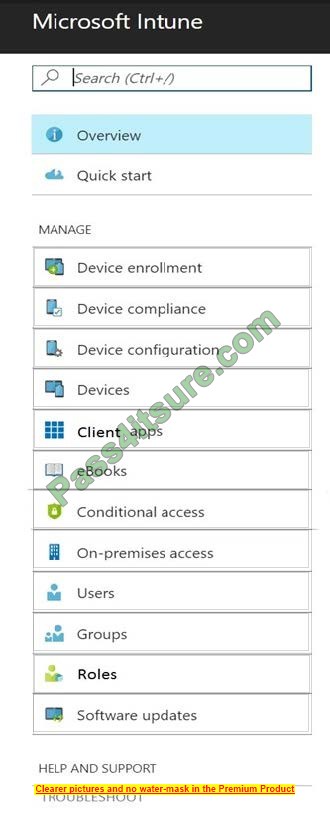
Correct Answer:
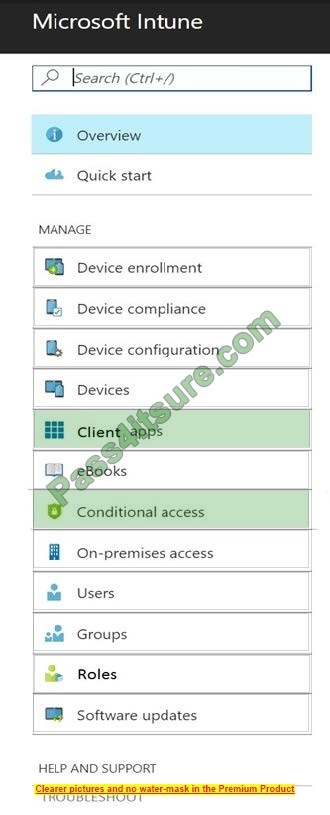
Box 1: Client Ensure that when users use the Intune Managed Browser to access Office 365 web interfaces, they can only copy data to applications that are managed by the company.
Box 2: Conditional Access Allow only the Microsoft Intune Managed Browser to access Office 365 web interfaces.
Organizations can use Azure AD Conditional Access policies to ensure that users can only access work or school content using Edge for iOS and Android. To do this, you will need a conditional access policy that targets all potential users.
These policies are described in Conditional Access: Require approved client apps or app protection policy.
Question 3:
You have a Microsoft Deployment Toolkit (MDT) deployment share.
You plan to deploy Windows 10 by using the Standard Client Task Sequence template.
You need to modify the task sequence to perform the following actions:
1. Format disks to support Unified Extensible Firmware Interface (UEFI).
2. Create a recovery partition.
Which phase of the task sequence should you modify?
A. Initialization
B. Install
C. PostInstall
D. Preinstall
Correct Answer: D
Create Extra Partition in MDT We will create a new task sequence for a machine that doesn’t have an extra partition.
1. On the Select Template page, click the drop-down and select Standard Client Task Sequence. Complete the remaining steps.
2. Edit the task sequence and click the New Computer Only step. Within that step, click Format and Partition Disk(BIOS) step and edit it.
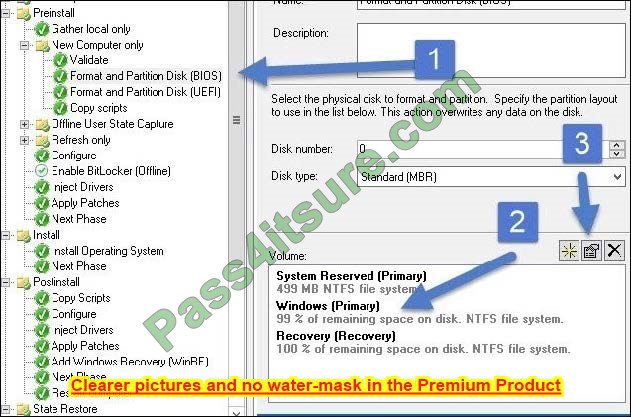
Etc.
Question 4:
You have an Azure Active Directory (Azure AD) tenant named adatum.com that contains two computers named Computer1 and Computer2. The computers run Windows 10 and are members of a group named GroupA.
The tenant contains a user named User1 that is a member of a group named Group1.
You need to ensure that if User1 changes the desktop background on Computer1, the new desktop background will appear when User1 signs in to Computer2.
What should you do?
A. Create a device configuration profile for Windows 10 and configure the Shared multi-user device settings. Assign the profile to Group 1.
B. Create a device configuration profile for Windows 10 and configure the Shared multi-user device settings. Assign the profile to GroupA.
C. From the Azure Active Directory admin center, enable Enterprise State Roaming for Group 1.
D. From the Azure Active Directory admin center, enable Enterprise State Roaming for GroupA.
Correct Answer: C
Enterprise State Roaming provides users with a unified experience across their Windows devices and reduces the time needed for configuring a new device.
Reference: https://docs.microsoft.com/en-us/azure/active-directory/devices/enterprise-state-roaming-enable
Question 5:
Your company has a System Center Configuration Manager deployment that uses hybrid mobile device management (MDM). All Windows 10 devices are Active Directory domain-joined.
You plan to migrate from hybrid MDM to Microsoft Intune standalone.
You successfully run the Intune Data Importer tool.
You need to complete the migration.
Which two actions should you perform? Each correct answer presents part of the solution.
NOTE: Each correct selection is worth one point.
A. In Intune, add a device enrollment manager (DEM).
B. Change the tenant MDM authority to Intune.
C. Assign all users Intune licenses.
D. Create a new Intune tenant.
Correct Answer: BC
References: https://docs.microsoft.com/en-us/sccm/mdm/deploy-use/migrate-hybridmdm-to-intunesa https://docs.microsoft.com/en-us/sccm/mdm/deploy-use/migrate-prepare-intune https://docs.microsoft.com/en-us/sccm/mdm/deploy-use/change-mdm-authority
Question 6:
Note: This question is part of a series of questions that present the same scenario. Each question in the series contains a unique solution that might meet the stated goals. Some question sets might have more than one correct solution, while others might not have a correct solution.
After you answer a question in this section, you will NOT be able to return to it. As a result, these questions will not appear on the review screen.
You have a computer that runs Windows 8.1.
Two days ago, you upgraded the computer to Windows 10.
You need to downgrade the computer to Windows 8.1.
Solution: From the Settings app, you use the Recovery options.
Does this meet the goal?
A. Yes
B. No
Correct Answer: A
Windows 10 supports a Rollback feature that allows you to go back (recover) to the version of Windows (Windows 10, Windows 7, or Windows 8.1) installed on your PC prior to upgrading to the latest version of Windows 10 or Windows 7 / 8.1
1) Click on Start > Settings >
2) In the Windows Setting options click on Update and security
3) In the column of option on the left side of Windows Update click on the \’Recovery\’ option.
4) Click on \’Get started\’ to start the Recovery / Rollback process
5) Etc.
Reference:
Question 7:
You have a Microsoft 365 E5 subscription that contains 100 Windows 10 devices enrolled in Microsoft Intune.
You plan to use Endpoint analytics.
You need to create baseline metrics.
What should you do first?
A. Create an Azure Monitor workbook.
B. Onboard 10 devices to Endpoint analytics.
C. Create a Log Analytics workspace.
D. Modify the Baseline regression threshold.
Correct Answer: B
Onboarding from the Endpoint analytics portal is required for Intune-managed devices. Reference: https://docs.microsoft.com/en-us/mem/analytics/enroll-intune
Question 8:
You have an Azure Active Directory (Azure AD) tenant named contoso.com.
You have a workgroup computer named Computer1 that runs Windows 10.
You need to add Computer1 to contoso.com.
What should you use?
A. the Settings app
B. Computer Management
C. netdom.exe
D. dsregcmd.exe
Correct Answer: D
If you want to manually join the computer to Azure AD, you can execute the disregard/join command. This command should be run in the SYSTEM context (using psexec for example) and will force an attempt to Azure AD.
Reference: https://365bythijs.be/2019/11/02/troubleshooting-hybrid-azure-ad-join/
Question 9:
You have a Microsoft 365 subscription.
You have 10 computers that run Windows 10 and are enrolled in mobile device management (MDM).
You need to deploy the Microsoft 365 Apps for the enterprise suite to all the computers.
What should you do?
A. From the Endpoint Manager admin center, add an app.
B. From Microsoft Azure Active Directory (Azure AD), add an app registration.
C. From Microsoft Azure Active Directory (Azure AD), add an enterprise application.
D. From the Endpoint Manager admin center, create a Windows 10 device profile.
Correct Answer: A
Before you can assign, monitor, configure, or protect apps, you must add them to Intune. Select Microsoft 365 Apps.
1. Sign in to the Microsoft Endpoint Manager admin center.
2. Select Apps > All Apps> Add.
3. Select Windows 10 in the Microsoft 365 Apps section of the Select App type pane.
4.
Click Select. The Add Microsoft 365 Apps steps are displayed.
Reference: https://docs.microsoft.com/en-us/mem/intune/apps/apps-add-office365
Question 10:
You have 200 computers that run Windows 10. The computers are joined to Microsoft Azure Active Directory (Azure AD) and enrolled in Microsoft Intune.
You need to ensure that only applications that you explicitly allow can run on the computers.
What should you use?
A. Windows Defender Credential Guard
B. Windows Defender Exploit Guard
C. Windows Defender Application Guard
D. Windows Defender Application Control
Correct Answer: D
Application control can help mitigate these types of security threats by restricting the applications that users are allowed to run and the code that runs in the System Core (kernel). Application control policies can also block unsigned scripts and MSIs, and restrict Windows PowerShell to run in Constrained Language Mode.
Question 11:
You need to recommend a solution to meet the device management requirements.
What should you include in the recommendation? To answer, select the appropriate options in the answer area.
NOTE: Each correct selection is worth one point.
Hot Area:
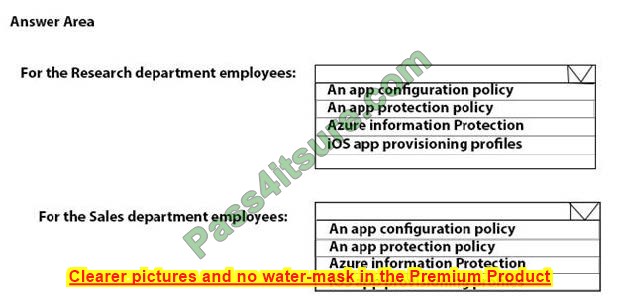
Correct Answer:
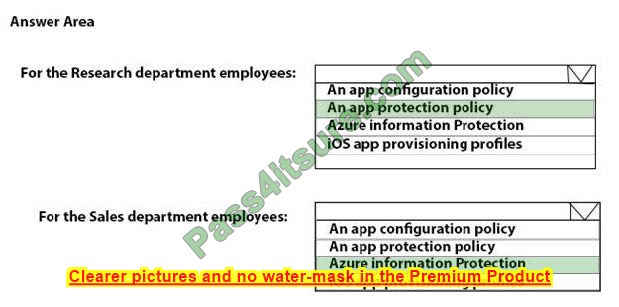
From the scenario:
Litware identifies the following device management requirements:
1. Prevent the sales department employees from forwarding an email that contains bank account information.
2. Ensure that Microsoft Edge Favorites are accessible from all computers to which the developers sign in.
3. Prevent employees in the research department from copying patented information from trusted applications to untrusted applications.
Box 1:
Employees in the research department must be prevented from copying patented information from trusted applications to untrusted applications. This requires an App protection policy.
App protection policies make sure that the app-layer protections are in place. For example, you can:
1. Require a PIN to open an app in a work context
2. Control the sharing of data between apps
Prevent the saving of company app data to a personal storage location
Box 2:
Employees in the sales department must be prevented from forwarding email that contains bank account information.
Azure Information Protection is a cloud-based solution that helps an organization to classify and optionally, protect its documents and emails by applying labels.
Labels can be applied automatically by administrators who define rules and conditions, manually by users, or a combination where users are given recommendations.
Reference:
https://docs.microsoft.com/en-us/intune/app-protection-policy
https://docs.microsoft.com/en-us/azure/information-protection/what-is-information-protection
Question 12:
HOTSPOT
You have a Microsoft 365 tenant that uses Microsoft Intune to manage the devices shown in the following table.

You need to deploy a compliance solution that meets the following requirements:
1. Marks the devices as Not Compliant if they do not meet compliance policies
2. Remotely locks noncompliant devices
What is the minimum number of compliance policies required, and which devices support the remote lock action? To answer, select the appropriate options in the answer area.
NOTE: Each correct selection is worth one point.
Hot Area:
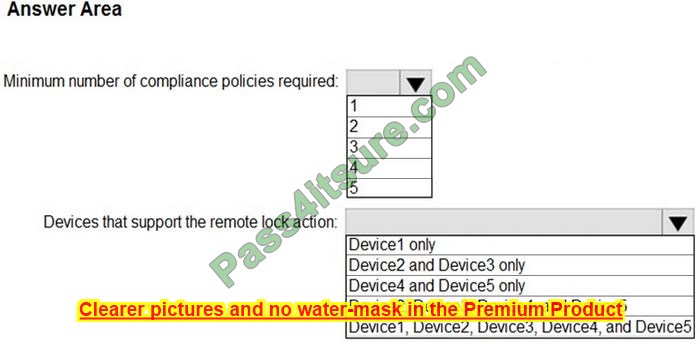
Correct Answer:
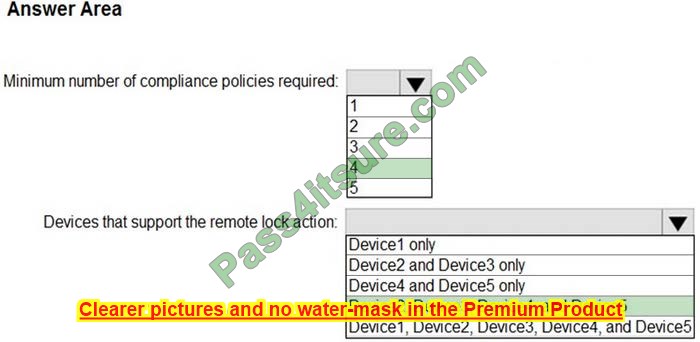
Box 1: 4 Windows, Android Enterprise, Android, and one for iOS/iPad.
Box 2: Device2, Device3, Device4, and Device5
A remote lock is supported for the following platforms:
Android Enterprise kiosk devices
Android Enterprise work profile devices
Android Enterprise fully managed devices
Android Enterprise corporate-owned with work profile devices
iOS macOS
Reference:
https://docs.microsoft.com/en-us/mem/intune/remote-actions/device-remote-lock
Question 13:
Note: This question is part of a series of questions that present the same scenario. Each question in the series contains a unique solution that might meet the stated goals. Some question sets might have more than one correct solution, while others might not have a correct solution.
After you answer a question in this section, you will NOT be able to return to it. As a result, these questions will not appear on the review screen.
Your company has an Azure Active Directory (Azure AD) tenant named contoso.com and a Microsoft Intune subscription.
Contoso.com contains a user named [email protected].
You have a computer named Computer1 that runs Windows 8.1.
You need to perform an in-place upgrade of Computer1 to Windows 10.
Solution: You assign an Enterprise Mobility + Security license to User1. You instruct User1 to sign in to Computer1.
Does this meet the goal?
A. Yes
B. No
Correct Answer: B
Instead: From Windows 8.1, you run setup.exe from the Windows 10 installation media. How To Upgrade To Windows 10 Using ISO File
1. Open your existing Windows edition and locate the ISO file. Now right-click on this file and Mount, and restart the machine. After rebooting, open File Explorer and locate the DVD drive, you\’ll find that the ISO file is already mounted to it with a temporary drive letter (as you can see in the below-shown window, where D: is the temporary drive letter). Open this drive and click on the setup.exe file.
Reference: https://www.kapilarya.com/how-to-upgrade-to-windows-10-using-iso-file
Question 14:
You have Windows 10 devices that are managed by using Microsoft Intune. Intune and the Microsoft Store for Business are integrated.
You need to deploy the Remote Desktop modern app as an automatic install to Windows 10 devices without user interaction.
Which three actions should you perform? Each correct answer presents part of the solution.
NOTE: Each correct selection is worth one point.
A. Create an Azure Active Directory group that contains all users.
B. From the Intune portal, create a Microsoft Store app for the Remote Desktop modern app.
C. From the Intune portal assign the app to the Azure Active Directory group.
D. Create an Azure Active Directory group that contains Windows 10 devices.
E. From the Microsoft Store for Business portal, assign a license for the app to all the users in the Azure Active Directory group.
F. For your organization, make the app available in the Microsoft Store for Business.
Correct Answer: BCD
Step 1: Create an Azure Active Directory group that contains Windows 10 devices.
Step 2: From the Endpoint Manager admin center, create a Microsoft Store app for the Remote Desktop modern app.
Step 3: From the Endpoint Manager admin center, assign the app to the Azure Active Directory group.
Reference:
https://docs.microsoft.com/en-us/mem/intune/apps/store-apps-windows
https://docs.microsoft.com/en-us/mem/intune/apps/apps-deploy
https://docs.microsoft.com/en-us/mem/intune/apps/windows-store-for-business
https://docs.microsoft.com/en-us/mem/intune/apps/apps-add
Question 15:
You have a Microsoft 365 tenant that uses Microsoft Intune for mobile device management (MDM).
You associate a Microsoft Store for Business account with Intune.
You purchase an app named Appl from the Microsoft Store for Business.
You need to ensure that Appl can be deployed by using Intune.
What should you do?
A. Sync purchased apps from the Microsoft Store for Business.
B. Integrate the Windows Autopilot Deployment Program into the Microsoft Store for Business.
C. Create an app category in Intune.
D. Create an app protection policy in Intune.
Correct Answer: A
Synchronize apps If you\’ve already associated your Microsoft Store for Business account with your Intune admin credentials, you can manually sync your Microsoft Store for Business apps with Intune using the following steps.
1. Select Tenant Administration> Connectors and tokens > Microsoft Store for Business.
2. Click Sync to get the apps you\’ve purchased from the Microsoft Store into Intune.
Note: You can synchronize the list of apps you have purchased (or that are free) from the store with Intune.
Apps that are synchronized appear in the Intune administration console; you can assign these apps like any other app.
Both Online and Offline licensed versions of Apps are synchronized to Intune. App names will be appended with “Online” or “Offline” in the portal.
Reference:
https://docs.microsoft.com/en-us/mem/intune/apps/windows-store-for-business
Now it’s time to know how to get certified through the exam. Getting an MD-101 dump is key, and practice exam questions are necessary. Download more MD-101 exam questions now https://www.pass4itsure.com/md-101.html (414 Q&As)